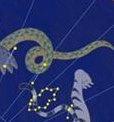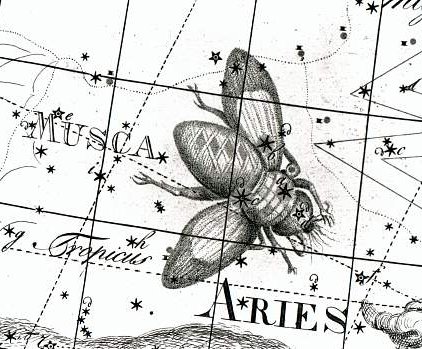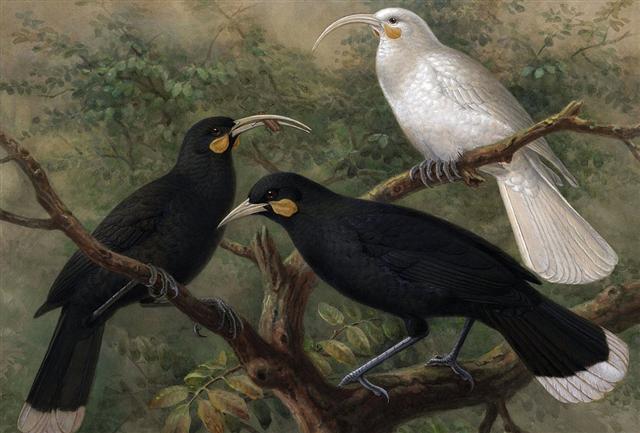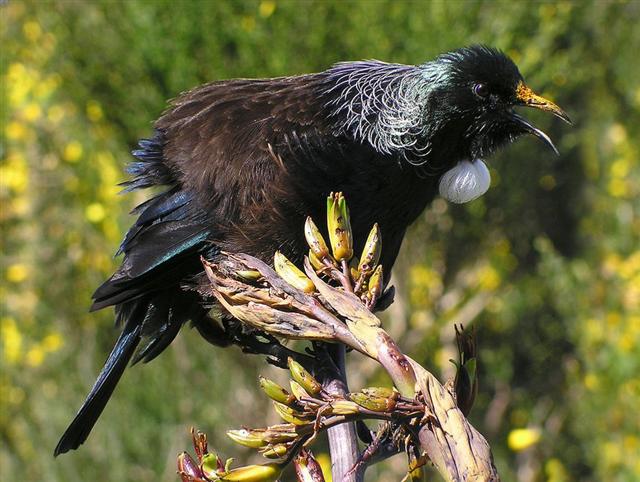101. Makoi went on his own to familiarize himself with the terrain. No less than 4 stations he visited by himself: ... When it grew light, Makoi arose again. He went off to further explore the area. He went along and came to the 'dark rat'. He looked around and said: 'Here we are at the dark rat of Hau Maka'. He gave it the name Te Kioe Uri A Hau Maka. He went on and came to Te Piringa Aniva. When he arrived there, he looked around and gave the name Te Piringa Aniva. He went on and came to Te Pei, looked around, and said, 'Here it is!' So he gave the name Te Pei A Hau Maka. He went on, all alone he went on, and came to Te Pou. When he arrived there, he looked around and again said, 'Here it is!' and gave the name Te Pou A Hau Maka. He sat down and rested. There was no bride-donor (tumu) to live with (? kia ora). He got up, the path went uphill, and he came (back) to the house. It was dark when he reached the house. When he came to the yam plantation of Kuukuu, he sat down. Night was falling. Ira asked Makoi the following question: 'How did you fare when you wandered, when you went searching, when you found yourself on the path of the dream soul of the father?' Makoi replied, 'There are indeed all those places. I did not forget them at all (? kai viri kai viri) when I saw them (text corrected, i-ui-nei). I alone saw no fewer than four of my [sic!] places, and I returned here only because night was falling.' Then Ira spoke again: 'How did you name them, last-born?' Makoi replied, 'This is what happened, this is how I gave the names. I wrote (ta) Te Manavai A Hau Maka on the surface of a banana leaf (kaka), and this is how I left it.' This is how Makoi remembered it. No sooner had he said this, when Ira gew angry and quarreld with Makoi. He said the following (to him): 'You did not pay attention, last-born, and you did not give the (full) name. This is how it should be: the Manavai of Hau Maka of Hiva, in memory (mo aringa ora) of the father, of his dream soul.' Makoi replied, 'In Hiva the land belongs to him - this land here is mine, not his!' They stayed (there longer). On the fifth day of the month of July ('Anakena'), they all got up, went downhill, went on, and reached Hanga Te Pau ... Might this not be a Sign of a quarter in excess of the current Sun year in order to cover also the nights which the precession had moved ahead since the ancient 'dream time' when the stars and the dates were coordinated? Let's speculate: Hanga Te Pau was where the Explorers had landed, then they went uphill to build a house and to dig the ground, and then they went downhill and returned to Hanga Te Pau. They in a way made a loop in time-space.
This resembles how the Chinese returned to a point 5-6 days before the winter solstice after having reached the early days in April: ... In China, every year about the beginning of April, certain officials called Sz'hüen used of old to go about the country armed with wooden clappers. Their business was to summon the people and command them to put out every fire. This was the beginning of the season called Han-shih-tsieh, or 'eating of cold food'. For three days all household fires remained extinct as a preparation for the solemn renewal of the fire, which took place on the fifth or sixth day after the winter solstice [Sic!] ... ... The 5th or 6th day after the northern winter solstice should be December 26 (360) or December 27 (361). The beginning of April could refer to a date according to some star calendar, and from day 361 to APRIL 1 (91) there were 4 + 91 = 95 days ... But I should revise my earlier estimate slightly, because we ought to - when operating with star positions - use 366 nights (right ascension days) for a year. APRIL 1 (366 + 91) - 361 = 96. 2 * 96 ('Sun') + 2 * 84 ('Moon') = 360. And 360 + 96 (Sun) = 456 = 3 * 96 (Sun) + 2 * 84 (Moon) = 288 (Sun) + 168 (Moon). Early I placed the first 24 of the kuhane stations in the following table, following the remarks of Barthel in his The Eighth Island, and at the same time I tried to find a reasonable distribution of the calendar days:
96 could perhaps be explained as 80 (0h) + 16 (nights before the stars returned to visibility after having risen heliacally) and 84 as the day number for the Julian equinox. 3 * 16 (= 3 * 96 - 3 * 80) = 48 = 288 - 240. And 240 ('Sun') + 168 ('Moon') = 408 (= 3 * 136 = 360 + 48). This was where evidently Sirrah (the Navel of the Pegasus Horse) had been placed in the G text:
The 4 stations which Makoi visited alone could perphaps have measured 4 * 14 (alluding to Bharani, i.e. to 41 Arietis at *41.4) = 56 right ascension days. ... 414 (= 314 + 100) symbolized a new beginning because 413 = 14 * 29½ ...
He Maro and He Anakena corresponded to the pair of winter solstice months on Easter Island. Only these months had the prefix He.
Makoi was in error (he), said Ira: ... You did not pay attention, last-born, and you did not give the (full) name ... Probably the creators of Manuscript E were here making a Sign in order for the reader not to miss what was going on. I have black-marked the 4 kuhane stations in the months He Maro and He Anakena. Anciently they may have counted with only 10 months for the Sun: ... From the natives of South Island [of New Zealand] White [John] heard a quaint myth which concerns the calendar and its bearing on the sweet potato crop. Whare-patari, who is credited with introducing the year of twelve months into New Zealand, had a staff with twelve notches on it. He went on a visit to some people called Rua-roa (Long pit) who were famous round about for their extensive knowledge. They inquired of Whare how many months the year had according to his reckoning. He showed them the staff with its twelve notches, one for each month. They replied: 'We are in error since we have but ten months. Are we wrong in lifting our crop of kumara (sweet potato) in the eighth month?' Whare-patari answered: 'You are wrong. Leave them until the tenth month. Know you not that there are two odd feathers in a bird's tail? Likewise there are two odd months in the year.' The grateful tribe of Rua-roa adopted Whare's advice and found the sweet potato crop greatly improved as the result ... The Maori further accounted for the twelve months by calling attention to the fact that there are twelve feathers in the tail of the huia bird and twelve in the choker or bunch of white feathers which adorns the neck of the parson bird ...
Presumably Makoi went on his own because these 'odd feathers' in the tail of the Sun bird were in the long pit (Rua-roa).
At the time of rongorongo the hard and dry Maro month (June) on Easter Island was what ruled at the winter solstice - it was not a gentle, easy, and soft (maru) season. If my idea of counting 14 nights for each winter ('Moon') kuhane station should be correct, then we could define the 'loop' of Makoi as 4 * 14 = 56 nights. Alcyone rose with the Sun in May 16 (*56, 136). And there were 136 days from "June 1 (152) to "October 15 (288). In other words when on Easter Island Antares at the time of Bharani had risen heliacally in "October 15 this was like a mirror image of how north of the equator and at the time of rongorongo Alcyone rose heliacally in May 16 (136). Furthermore, 288 (Tangaroa Uri 15) - 136 = 152 (Maro 1) = 136 + 16 (nights before the stars returned to visibility after having risen heliacally). ... "October - 6 months = "June. 288 - 152 ("June 1) = 136 (alluding to Alcyone in May 16). And 288 - 115 ("April 25) = 173 = 183 - 10. The Explorers left Easter Island 10 days after Hotu had arrived.
The 'loop' of Makoi resembles the loop of Lono on Hawaii: ... in the ceremonial course of the coming year, the king is symbolically transposed toward the Lono pole of Hawaiian divinity ... It need only be noticed that the renewal of kingship at the climax of the Makahiki coincides with the rebirth of nature. For in the ideal ritual calendar, the kali'i battle follows the autumnal appearance of the Pleiades, by thirty-three days - thus precisely, in the late eighteenth century, 21 December, the winter solstice. The king returns to power with the sun. Whereas, over the next two days, Lono plays the part of the sacrifice ... ... The correspondence between the winter solstice and the kali'i rite of the Makahiki is arrived at as follows: ideally, the second ceremony of 'breaking the coconut', when the priests assemble at the temple to spot the rising of the Pleiades, coincides with the full moon (Hua tapu) of the twelfth lunar month (Welehu). In the latter eighteenth century, the Pleiades appear at sunset on 18 November. Ten days later (28 November), the Lono effigy sets off on its circuit, which lasts twenty-three days, thus bringing the god back for the climactic battle with the king on 21 December, the solstice (= Hawaiian 16 Makali'i). The correspondence is 'ideal' and only rarely achieved, since it depends on the coincidence of the full moon and the crepuscular rising of the Pleiades ...
... I have here above assumed the date given for Hua tapu in the 12th month Welehu - and indirectly also for the date at the beginning of the circuit of Lono - was not according to the Gregorian calendar but according to the Julian calendar as applied to the stars in Roman times ... Julius Caesar had connected the Sun cycle with the star cycle in a correct way:
 ... The Makahiki effigy is dismantled and hidden away in a rite watched over by the king's 'living god', Kahoali'i or 'The-Companion-of-the-King', the one who is also known as 'Death-is-Near' (Koke-na-make). Close kinsman of the king as his ceremonial double, Kahoali'i swallows the eye of the victim in ceremonies of human sacrifice ... In the deep night before the image [of Lono] is first seen, there is a Makahiki ceremony called 'splashing-water' (hi'uwai). Kepelino tells of sacred chiefs being carried to the water where the people in their finery are bathing; in the excitement created by the beauty of their attire, 'one person was attracted to another, and the result', says this convert to Catholicism, 'was by no means good'. At dawn, when the people emerged from their amorous sport, there standing on the beach was the image of Lono. White tapa cloth and skins of the ka'upu bird hang from the horizontal bar of the tall crosspiece image. The ka'upu is almost certainly the albatross, a migratory bird that appears in the western Hawaiian chain - the white Lanyon albatross at Ni'ihau Island - to breed and lay eggs in October-November, or the beginning of the Makahiki season ... 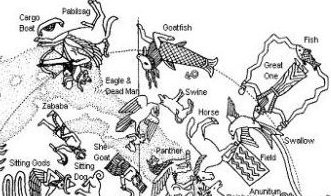  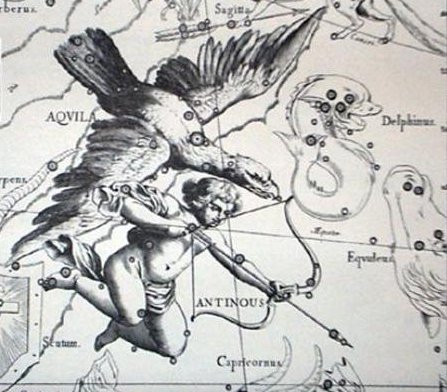 ... Tav is the last letter of the Hebrew word emet, which means truth. The midrash explains that emet is made up of the first, middle, and last letters of the Hebrew alphabet (Aleph, Mem, and Tav...). Sheqer (falsehood), on the other hand, is made up of the 19th, 20th, and 21st (and penultimate) letters. Thus, truth is all-encompassing, while falsehood is narrow and deceiving. In Jewish mythology it was the word emet that was carved into the head of the Golem which ultimately gave it life. But when the letter 'aleph' was erased from the Golem's forehead, what was left was 'met' - dead. And so the Golem died ...
|
|||||||||||||||||||||||||||||||||||||||||||||||||||||||||||||||||||||||||||||||||||||||||||||||||||||||||||||||||||||||||||||||||||||||||||||||||||||||||||||||||||||||||||||||||||||||||||||||||||||||||||||||||||||||||||||||||||||||||||||||||||||||||||||||||||||||||||||||||||||||||||||||||||||||||||||||||||||||||||||||||||||||||||||||||||||||||||||||||||||||||||||||||||||||||||||||||||||||||||||||||||||||||||||
